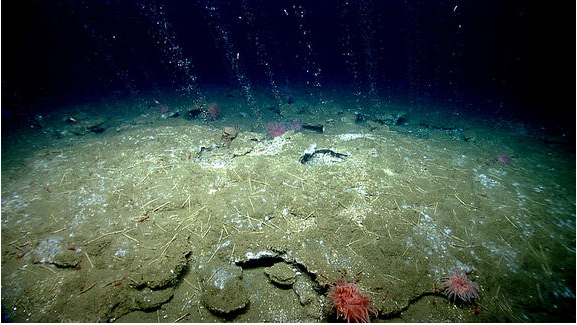Methane Plumes Found in the Atlantic Ocean
| Dino Lirios | | Aug 26, 2014 01:29 AM EDT |
(Photo : NOAA Okeanos Explorer Program, 2013 Northeast U.S. Canyons Expedition) Methane seeps in the Atlantic Ocean
Researchers have discovered hundreds of toxic methane plumes rising from the floor of the Atlantic Ocean, raising the specter of higher greenhouse gas levels.
Some 570 seeps were discovered from Cape Hatteras in North Carolina to Georges Bank in Massachusetts.
These seeps were discovered using sonar and video by the National Oceanographic and Atmospheric Administration ship, Okeanos Explorer, from 2011 to 2013.
Like Us on Facebook
The Explorer used sound waves to detect the seeps on the ocean floor. In a technique called multibeam sonar, the time and distance it takes for the sound waves to reach the ocean floor and return is measured.
The technique can also detect the contrast in density between gas bubbles and seawater.
The methane seeps were found at depths less than 1,640 feet. Researchers say that most of the seeps come from microbes.
The news surprised most scientists because only three natural gas seeps were found off the East Coast before 2012 despite methane vents being common around the world.
Scientists are interested in studying how methane is affected by climate change. Methane is a gas that dissipates quicker than carbon dioxide, but has the potential to warm the world faster.
Lead study author Adam Skarke, a geologist at Mississippi State University in Mississippi State said it was a surprise to find these features.
"It was unexpected because many of the common things associated with methane gas do not exist on the Atlantic margin."
The East Coast is described by geologists as a "passive margin" where methane isn't supposed to be found.
Researchers can't explain why there are so many methane plumes along the Atlantic coastline without further exploration.
They noted that if the East Coast could hide hundreds of methane pits, it's likely there are nearly 30,000 more awaiting discovery in the world's oceans.
Interest in the seeps is high because they could be a laboratory for studying how methane hydrates respond to climate change.
Methane is a greenhouse gas that has more warming power than carbon dioxide. Millions of tons of methane are frozen in the Arctic permafrost, on land and in the seafloor.
Scientists said they now have a study site where they can monitor these locations and see how they change.
"Finally we have a place where we can begin to address some of the questions about how water temperatures are influencing methane, said David Valentine, a geochemist at the University of California, Santa Barbara, who was not involved in the study.
Scientists believe the East Coast seeps don't contribute much methane to climate change since much of the methane gas dissolves in the ocean before reaching the surface.
A number of shallow-water seeps could vent methane to the surface. Researchers expect future surveys will discover more shallow seeps. These regions only received a quick look during the survey.
Even though methane may not escape to the atmosphere, the gas still adds to the ocean's overall carbon contentr.
©2015 Chinatopix All rights reserved. Do not reproduce without permission
EDITOR'S PICKS
-

Did the Trump administration just announce plans for a trade war with ‘hostile’ China and Russia?
-

US Senate passes Taiwan travel bill slammed by China
-

As Yan Sihong’s family grieves, here are other Chinese students who went missing abroad. Some have never been found
-

Beijing blasts Western critics who ‘smear China’ with the term sharp power
-

China Envoy Seeks to Defuse Tensions With U.S. as a Trade War Brews
-

Singapore's Deputy PM Provides Bitcoin Vote of Confidence Amid China's Blanket Bans
-

China warns investors over risks in overseas virtual currency trading
-

Chinese government most trustworthy: survey
-

Kashima Antlers On Course For Back-To-Back Titles
MOST POPULAR
LATEST NEWS
Zhou Yongkang: China's Former Security Chief Sentenced to Life in Prison

China's former Chief of the Ministry of Public Security, Zhou Yongkang, has been given a life sentence after he was found guilty of abusing his office, bribery and deliberately ... Full Article
TRENDING STORY

China Pork Prices Expected to Stabilize As The Supplies Recover

Elephone P9000 Smartphone is now on Sale on Amazon India

There's a Big Chance Cliffhangers Won't Still Be Resolved When Grey's Anatomy Season 13 Returns

Supreme Court Ruled on Samsung vs Apple Dispute for Patent Infringement

Microsoft Surface Pro 5 Rumors and Release Date: What is the Latest?










